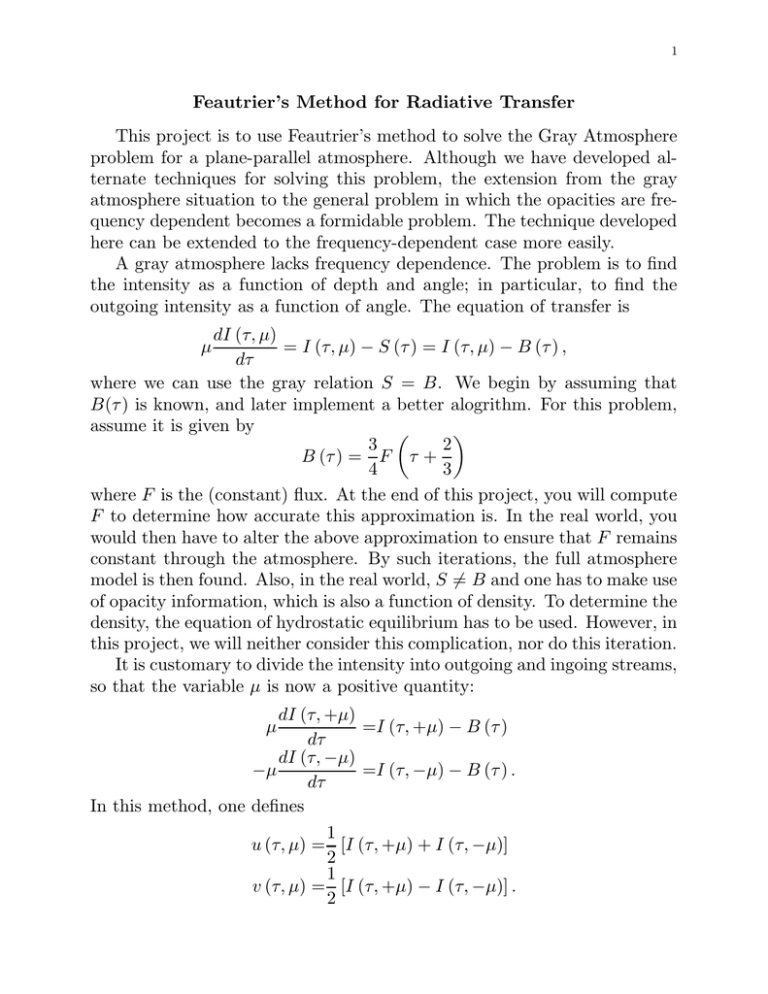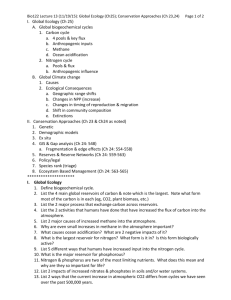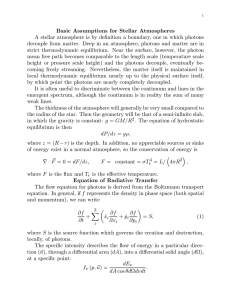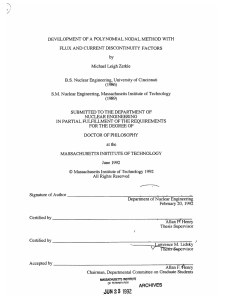Feautrier’s Method for Radiative Transfer
advertisement

1 Feautrier’s Method for Radiative Transfer This project is to use Feautrier’s method to solve the Gray Atmosphere problem for a plane-parallel atmosphere. Although we have developed alternate techniques for solving this problem, the extension from the gray atmosphere situation to the general problem in which the opacities are frequency dependent becomes a formidable problem. The technique developed here can be extended to the frequency-dependent case more easily. A gray atmosphere lacks frequency dependence. The problem is to find the intensity as a function of depth and angle; in particular, to find the outgoing intensity as a function of angle. The equation of transfer is dI (τ, µ) = I (τ, µ) − S (τ ) = I (τ, µ) − B (τ ) , dτ where we can use the gray relation S = B. We begin by assuming that B(τ ) is known, and later implement a better alogrithm. For this problem, assume it is given by 2 3 B (τ ) = F τ + 4 3 where F is the (constant) flux. At the end of this project, you will compute F to determine how accurate this approximation is. In the real world, you would then have to alter the above approximation to ensure that F remains constant through the atmosphere. By such iterations, the full atmosphere model is then found. Also, in the real world, S 6= B and one has to make use of opacity information, which is also a function of density. To determine the density, the equation of hydrostatic equilibrium has to be used. However, in this project, we will neither consider this complication, nor do this iteration. It is customary to divide the intensity into outgoing and ingoing streams, so that the variable µ is now a positive quantity: µ dI (τ, +µ) =I (τ, +µ) − B (τ ) dτ dI (τ, −µ) −µ =I (τ, −µ) − B (τ ) . dτ In this method, one defines 1 u (τ, µ) = [I (τ, +µ) + I (τ, −µ)] 2 1 v (τ, µ) = [I (τ, +µ) − I (τ, −µ)] . 2 µ 2 Thus, dv (τ, µ) =u (τ, µ) − B (τ ) dτ du (τ, µ) =v (τ, µ) . µ dτ We can combine them to eliminate v: d2 u (τ, µ) 2 µ = u (τ, µ) − B (τ ) dτ 2 The boundary conditions on I are taken to be that of no incoming flux at the surface, and the diffusion approximation at the atmosphere’s base: I (0, −µ) =0 d2 B (τ ) dB (τ ) 2 + ··· +µ I (τ → ∞, +µ) = B (τ ) + µ . dτ d2 τ τ →∞ We ignore second and higher derivatives of B. The boundary conditions become du (τ → 0, µ) =v (0, µ) = u (0, µ) µ dτ dB (τ ) du (τ, µ) = B (τ ) + µ . [u (τ, µ) + v (τ, µ)]τ →∞ = u (τ, µ) + µ dτ dτ τ →∞ τ →∞ (1) To solve these equations, we must discretize them. Choose angles based upon Gauss-Legendre quadrature (for ease, choose 3 positive and 3 negative values for µj ). Choose optical depths ranging from 0 to, say, 10, with a fixed interval of ∆ = 0.1. Thus τi+1 − τi ≡ ∆. It would be better in general to choose ln τ for the independent variable for accuracy’s sake, but this complicates the algebra and a linear grid is sufficient here. We can write the system of equations for 1 < i < N ) as µ −Ai,j ui−1,j + Di,j ui,j − Ci,j ui+1,j = Ei . (2) For 2 ≤ i ≤ N − 1 one has, using central differencing, Ai,j = µ2j /∆2, Di,j = 1+2µ2j /∆2 , Ci,j = µ2j /∆2, Near τ = 0, we expand u in a Taylor series: Ei = Bi ≡ B (τi ) . 1 d2 u (τ → 0, µ) 2 du (τ → 0, µ) ∆+ u2,j 'u1,j + ∆ + ... dτ 2 dτ 2 ∆2 ∆ =u1,j + u1,j + u1,j − B1 . µj 2µ2j 3 Multiplying this by µj /∆, we can identify A1,j = 0, D1,j = 1 + µj /∆ + ∆ , 2µj C1,j = µj /∆, E1 = B1 ∆ . 2µj At the other boundary, we find AN,j =µj /∆ − 1/2, DN,j = 1/2 + µj /∆, CN,j = 0, EN = BN 1/2 + µj /∆ + BN −1 1/2 − µj /∆ . Eq. (2) is linear, and we can use a substitution scheme similar to that of the Henyey technique. Assume for each j, using the shorthand ui = ui,j , ui = αi+1 + βi+1 ui+1 . (3) Ei−1 + αi−1 Ai−1 , Di−1 − βi−1 Ai−1 Ci−1 βi = . Di−1 − βi−1 Ai−1 (4) By substitution, one finds αi = Beginning at the surface, β2 = C1 /D1 since A1 = 0. Now one can determine all αi s and βi s up to i = N + 1. In turn, one uses Eq. (3) to obtain each ui from i = N to i = 1. After the ui s are determined, one reconstructs the flux: Z +1 X F (τi ) =2 µI (τi , µ) dµ = 2 aj µj I τi , +µj − I τi , −µj −1 =4 X j aj µj vi,j = 4 X j aj µ2j u0i,j . j Here, wj are the Gauss-Legendre weights, and the sums are only over postive values of j. To find u0i,j = (du/dτ )i,j , use the discretized relation ui+1,j − ui−1,j , 2∆ which is valid for 2 ≤ i ≤ N −1. For the boundaries Taylor-series expansions can be used: 3uN,j + uN −2,j − 4uN −1,j 4u2,j − 3u1,j − u3,j , u0N,j = . u01,j = 2∆ 2∆ u0i,j = 4 For some reason, using the simpler result from the inner boundary condition that u01,j = u1,j /µj produces an instability in the iterations described below. How constant is F as a function of depth? Fig. 1 shows that near the surface, the flux is especially poorly determined. To ensure that F remains constant as a function of depth, it is necessary to alter the approximation B = (3F/4)(τ + 2/3). This procedure is commonly known as Λ-iteration, since Λ is the operator that yields S. Figure 1: The model flux Fmod as a function of optical depth for cases of different angular resolutions, m = 1, 3, 5. Improvement with increasing m is slow. In the gray atmosphere case, the constancy of the flux implies B = J, so one procedure would be to update B by using Z 1X 1 +1 Idµ = B (τ ) =J (τ ) = aj I τ, +µj + I τ, −µj 2 −1 2 j X = aj u τ, µj . j Once this value for B is used in the Feautrier scheme, new values for ui,j are determined. This iteration must be repeated until convergence. Unfortunately, typically thousands of iterations are necessary (see Fig. 2). This 5 happens because at large optical depth, we will always find J → B no matter what, and the changes in B are exponentially small. Note that the flux was not used in the computation of the correction of B. Figure 2: Λ iteration for different angular resolutions. Each curve shows the result of 10 successive iterations. Results for m = 1(5) are shifted by +0.01 (-0.01); somewhat better convergence with increasing m is evident. A better approach is the so-called Unsöld-Lucy procedure. Begin with the transfer equation and its first two moments, in the gray case with no scattering, in which case S = B: 1 dF dK 1 dI = I − B, = J − B, = F. µ dτ 4 dτ dτ 4 Since B is not the correct source function, F will not be constant. Integrate the last of the above relations: Z 1 τ 1 K (τ ) = F τ 0 dτ 0 + C, 4 0 3 where C is a constant. Now use the Eddington approximation J = 3K, and C can be found if we further approximate J(0) = F (0)/2, so Z 1 3 τ F τ 0 dτ 0 + F (0) . J' 4 0 2 6 The first moment equation becomes Z 1 dF (τ ) 3 τ 1 dF (τ ) 1 B (τ ) = J (τ ) − ' . F τ 0 dτ 0 + F (0) − 4 dτ 4 0 2 4 dτ Now, the correction ∆B(τ ) should be that which makes F constant: Z 3 τ ∗ 0 1 ∗ F dτ + F + ∆B (τ ) , B (τ ) ' 4 0 2 where F ∗ is the correct, constant, flux. So, Z 1 3 τ 1 d [F (τ ) − F ∗] ∗ 0 0 ∗ F τ − F dτ + [F (τ ) − F ] − . ∆B (τ ) = 4 0 2 4 dτ Even though we used a number of approximations, the correction term uses only flux information, so that convergence to the proper solution is guaranteed. This technique works well (Fig. 3). Note the expanded scale of the abcissa in Fig. 3. Typically, only 5 or 6 iterations are adequate. Figure 3: Unsöld-Lucy iteration. Each curve represents the result of 1 successive iteration. Results for m = 1(5) are shifted by +0.0001 (-0.0001).







